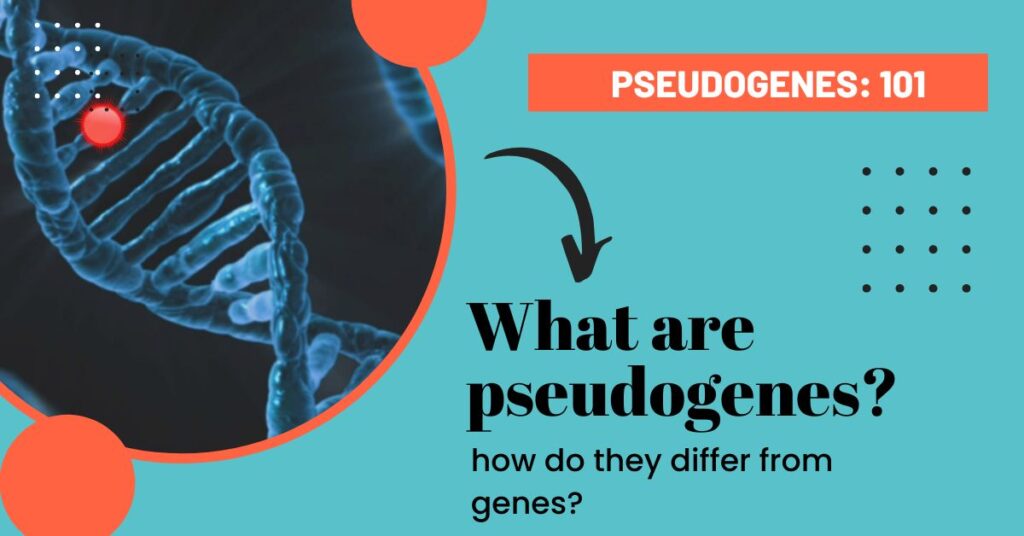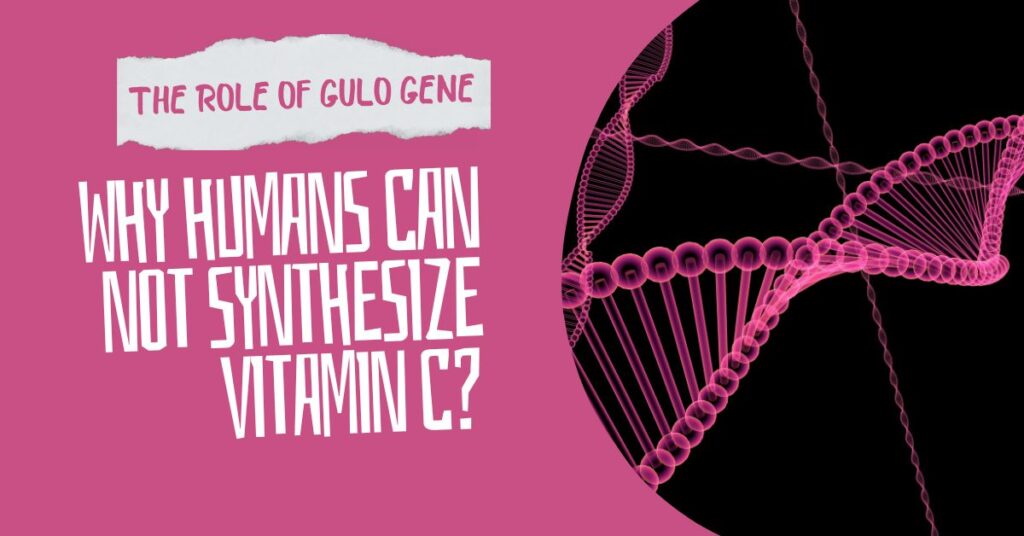“Discover the world of pseudogenes in this article; what are they and how are they different from genes? Deep dive into the complexity of genes and pseudogenes through this article.”
When we talk about a ‘gene’ what would be its basic function? What comes to your mind very first, as a genetics student? To synthesize a protein. And that’s what it means for. Right! The primary and very basic function of a typical gene.
However, our genome isn’t only about genes. A genome is complex and underrated, and yet not completely explored. The mystery is like the universe, as we explore it more and more, it becomes more and more complex to understand!
We now, know the coding part, even the non-coding part and their function; but the majority of the ‘dark matter’ portion is still unknown to us. One such part of our genome, which we are going to talk about in this article, is the region that contains structural elements very similar to genes. But are, in fact not genes!
Confusing? Let’s make it simple.
Pseudogenes are similar entities to our coding genes but are not genes because they don’t make any protein. In this article, we will learn what pseudogenes are and how they differ from genes.
Our mission at Genetic Education Inc. is to spread knowledge and re-discover it. The learning objectives of the present article are to understand the broad concept of pseudogenes and their function and comprehensive differences from genes.
Stay tuned.

Key Topics:
What are pseudogenes?
Pseudogenes are sequences or genetic elements that highly resemble the genes but lack functionality. Meaning, are structurally similar to genes but functionally not. So technically, they don’t have any significant role in protein synthesis.
This literally depicts that they can’t undergo the process of ‘translation’ however, studies suggest that some pseudogenes may take part in transcription and form RNA but fail to participate in the translation event.
After the recognition of junk DNA in the field of genetics, scientists categorized pseudogenes as just ‘junk’- sequences that lost their function over a course of evolution. However, recent findings demonstrate that they have a pivotal role in epigenetic regulation.
Acquisition of mutations during evolution made them inactive in different organisms, therefore, often known as “genomic fossils” or “dead genes” too. They work not only for gene regulation but also for synthesizing new genes, protein modification, tumor suppression and developmental processes.
In 1977, during their study of Xenopus Laevis, Jaq, Miller and Brownlee very first time reported any pseudogene for the 5S DNA gene. The number of pseudogenes in our human genome is almost similar to the number of genes. Approx. 20,000 pseudogenes have been reported to date.
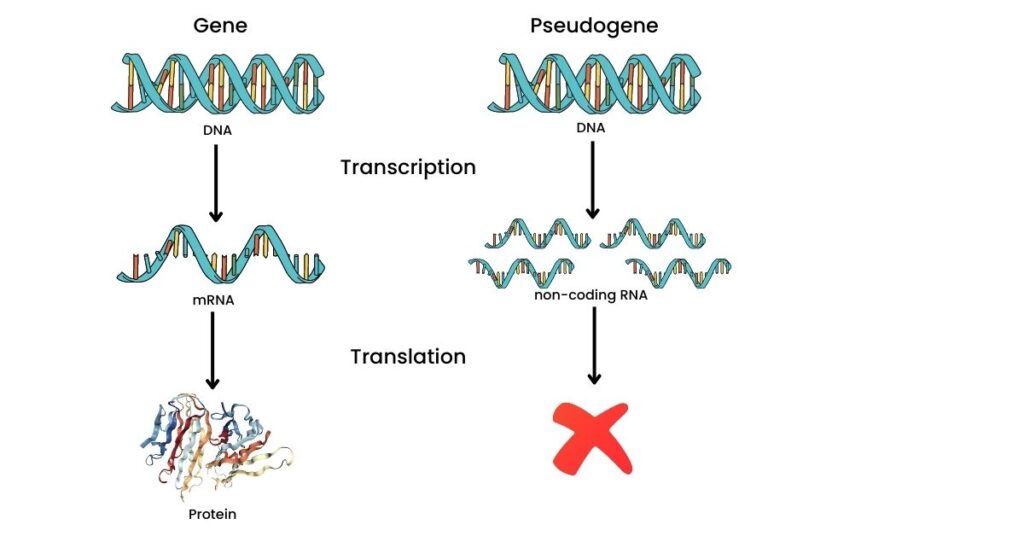
No of pseudogenes in different organisms:
| Organism | No. of genes | No of pseudogenes |
| Humans | 20,626 | 17,667 |
| House Mouse | 26,355 | 11,406 |
| Drosophila | 13,986 | 311 |
| Arabidopsis thaliana | 27,562 | 3922 |
| Zebrafish | 26,206 | 23,569 |
| Pig | 20,854 | 3,090 |
| Rice | 28,838 | 1620 |
| Chimpanzee | 21566 | 7644 |
| E Coli | 4,639 | 145 |
Types of pseudogenes:
To understand the theory of pseudogenes and their function, it’s important to understand their types, first. Two native types of pseudogenes are processed and unprocessed pseudogenes.
Processed pseudogenes:
This simply means that they may participate in the DNA metabolism process but fail to conceive their distinct gene structure and hence remain functionally inactive. For example, pseudogenes are formed by retrotransposition. Remember what retrotransposition is? Don’t know, first read this article: retrotransposition.
Retrotransposition reverse transcribed the RNA into DNA which is the cDNA with poly-A tail, and without any or one regulatory element like promoter or stop codons. This can’t be recognized as a gene and fails to participate in the translation, later on.
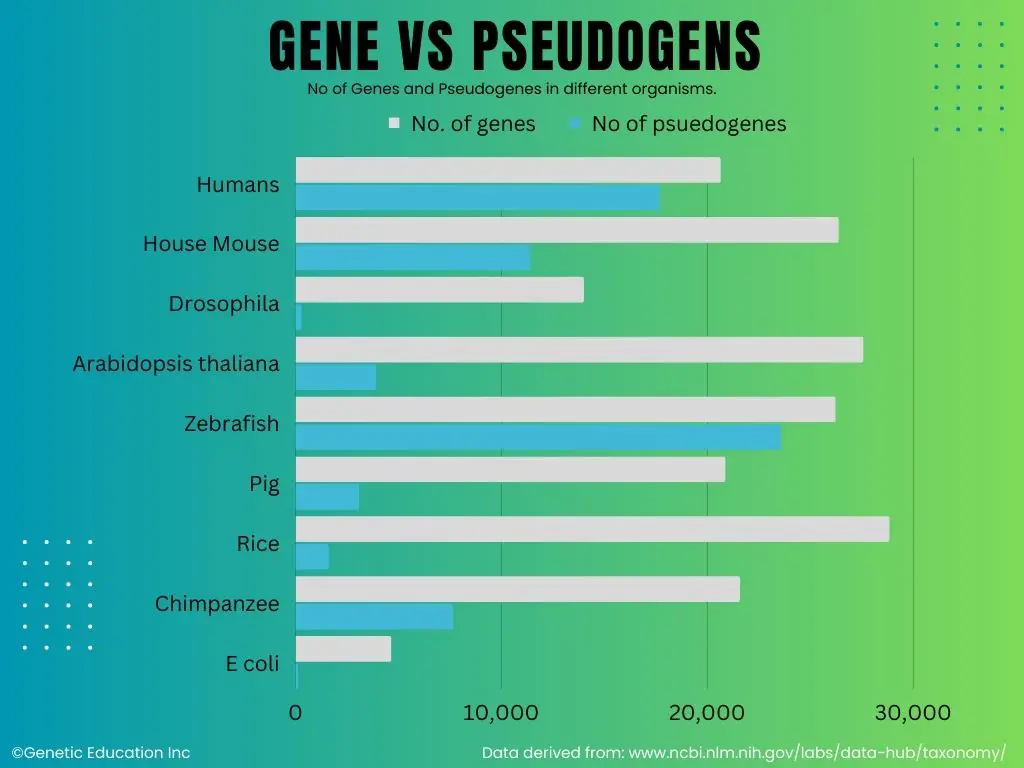
Non-processed pseudogenes:
This simply means that the formation of pseudogenes doesn’t involve any processing, occurring by any random event. Gene duplication is one such culprit event that makes any individual gene copy non-function.
Any mutation– insertion, deletion, duplication, frameshift or silent mutation occurs in a gene that makes it functionally inactive, however, may have intact intron and exons in its structure. Such mutations are accumulated over the course of millions of years of evolution to make the gene functionally inactive.
Extra knowledge: That inactivation is crucial as mutant genes may produce truncated, partial or abnormal proteins. Such abnormal protein products can’t help us but instead, inversely affect our system. It may cause cancer-like conditions. That’s why it’s important for nature to inactivate any mutant allele or gene which doesn’t look good.
Definition:
Pseudogenes are functionally inactive genes having a similar structure to genes but can’t synthesize any protein.
Functions of pseudogenes
Now the question is, if they don’t have any pivotal role in protein synthesis, do they really have any function, if so, what function do they execute in our genome? Or for any organisms? The answer is, ‘Yes’, they have a significant function in the regulation of gene expression and other processes.
However, it is important to note that from the entire cohort of all human pseudogenes, only 20% are still transcriptionally active to participate in various epigenetic activities. Pseudogenes, when processed through transcription, synthesize various non-coding RNAs (siRNA, miRNA, lncRNAs and sncRNAs) which can’t form a protein.
Several functions of pseudogenes are gene regulation, gene duplication, formation of new genes, post-translational modification, controlling oncogenic activities and driving the evolution process. Let us discuss each process comprehensively.
Pseudogenes and gene regulation:
Regulation of gene expression is defined as controlling the number of genes thereby the proteins formed during the translation process. Pseudogene-derived non-coding RNA products such as miRNA, shRNA or lncRNA play an extensive role in the epigenetic regulation of genes.
Such siRNAs are very crucial for regulating the miRNA-mediated mRNA degradation through RNA interference mechanism. Meaning, it controls the overall process of how much particular mRNA would be formed and undergo the event of translation.
Epigenetic control is the key function pseudogenes exhibit. They execute both, positive and negative gene regulation by controlling the over and underproduction of the mRNA by various mechanisms and through competitive binding.
Positive regulation occurs when a pseudogene and a gene share a common microRNA response element (MREs) and compete with each other for microRNA binding. This way it down-regulates the overproduction of gene transcript. Positive regulation has been governed by long non-coding RNA as well.
microRNAs, themselves, are a pseudogene product. Having high sequence homology with the original gene, It binds at the 3’ end of the mRNA transcript and disallows its processing thereby degrading it. Evidence also suggests that siRNA may also contribute to negative gene regulation as well.
The entire process of RNA interference is complex, I have written dedicated articles on each process. You can read them here.
New gene formation:
Pseudogenes can be a source of raw material for forming a new gene. Pseudogenes themselves are the product of gene duplication or recombination which makes them inactive entirely. However, as it has high sequence homology and active regulatory elements like the native gene, it may contribute to the formation of a new gene during consecutive rounds of gene duplication.
Furthermore, it may contribute new or lost sequences to the original gene and repair it too. The whole process occurs randomly.
Developmental process:
Studies also show that pseudogenes can also contribute to developmental processes too by forming lncRNA transcripts. For example, the PTENP1 pseudogene is a long non-coding RNA that is a pseudogene of the PTEN gene. It controls the tumor suppressor activity of the PTEN gene during the developmental stage. Meaning, it prevents cancer.
Contribute to evolution:
The most important benefit of pseudogenes is in evolution. It’s an interesting mechanism, how it contributes to producing new genotypes and gene variations. Pseudogenes are reservoirs of many mutations.
During millions of years, they acquire so many mutations. However, through recombination, they transfer any mutation to a highly resemble gene. And if it is advantageous, organisms may continue that copy of a gene (genotype).
Meaning, it may produce various genotypes, alleles and genes and thereby produce various beneficial traits. Nonetheless, oftentimes, it may create undesirable changes and can cause cancer, and other abnormalities or even convert the gene into a pseudogene.
How are pseudogenes different from genes?
Now let’s talk about how pseudogenes are different from our coding genes by comparing pseudogenes vs genes.
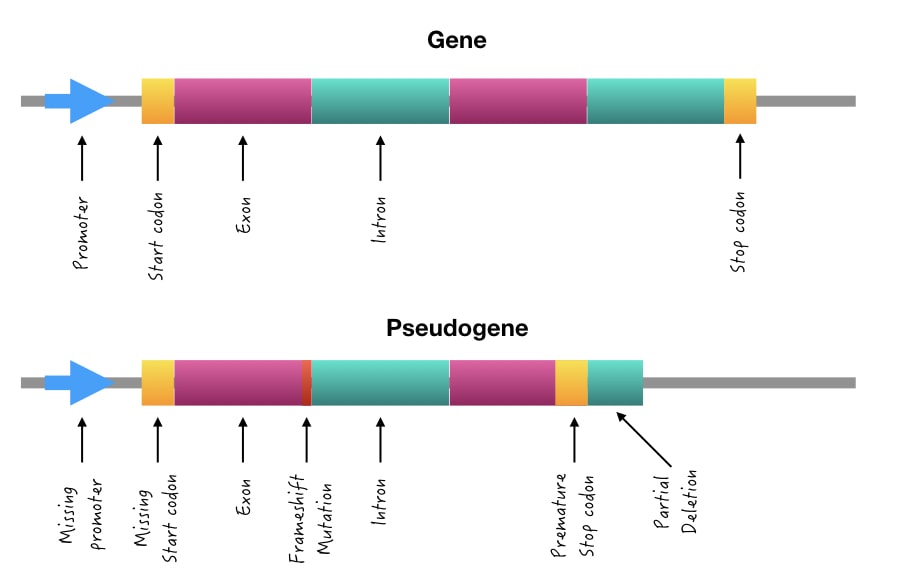
Pseudogenes are categorized into non-coding or junk DNA while genes are categorized into coding DNA. Keep in mind that previously called junk DNA has a role in the regulation of gene expression.
Pseudogenes are functionally inactive for protein synthesis while genes are functionally active for protein synthesis.
They can’t form any polypeptide chain whereas genes can participate in the synthesis of the polypeptide chain.
Pseudogenes resemble genes and can participate in replication and transcription. However, it can’t participate in the process of translation. Whereas, genes can participate in the replication, transcription and translation process.
Pseudogenes lack any or all of the regulatory elements while genes do have all the regulatory elements intact and functional.
Pseudogenes acquire mutations and become inactive. On the other hand, genes may acquire mutations and produce new traits.
Pseudogenes may participate in transcription and form non-coding RNAs like short interfering RNA. While coding genes participate in transcription and form coding RNAs like mRNA. mRNA is recognized for protein synthesis.
Pseudogenes don’t have any role in protein synthesis but are involved in the regulation of gene expression by RNA processing while genes have a direct role in protein synthesis but don’t involve in the regulation of gene expression.
Thus pseudogenes have significant importance in epigenetic studies while genes have significant importance in genetic studies.
Pseudogenes are formed by either retrotransposition or error during gene duplication. Conversely, genes are formed by duplication, transposition, lateral gene transfer, mutations and gene fusion.
Pseudogenes are functionally suppressed and might have abnormal start or stop codons while functional genes have accurate and correct start and stop codon locations.
Pseudogenes can contain frameshift or silent mutations, while genes don’t contain frameshift or silent mutations if it is functionally active.

Similarities between pseudogenes vs genes:
- Both are types of DNA- deoxyribose nucleic acid and are present in our genome.
- Both can participate in the transcription and make RNA (However, the products of transcription are different).
- Both have regulatory elements, however, pseudogenes may lack any or one such regulatory element.
- Both have introns and exons.
- Both can participate in DNA replication as well.
- The number of pseudogenes and genes are almost similar and hence share almost similar portions in the human genome.
- Common evolutionary events for both are gene duplication and DNA transposition.
Wrapping up:
In conclusion, much like ‘genes’, ‘pseudogenes’ are also important for any organism to survive on earth. Interesting studies on this topic also suggest that the number of mutations in any pseudogenes depicts its age.
Despite substantial innovations and discoveries in the field of genetics, pseudogenes are yet not fully understood. It also poses problems in gene assemblies and DNA sequence analysis due to their high sequence similarities.
The distinctly active functions of pseudogenes prevent cancer by suppressing tumorigenesis. So, they are a valuable genomic asset for us. That’s it for today’s article. We are covering the entire series on this topic. Other articles will come and I will post them here.
Till then, share this article, subscribe to our blog and allow notifications.
